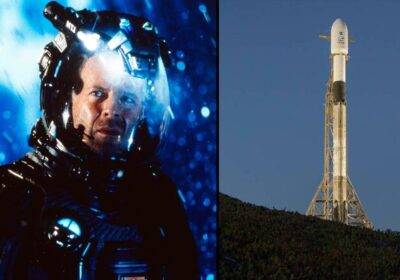U.S. officials have long invoked Bruce Willis’ name in the interests of planetary security.
At a 2013 Senate hearing with experts to discuss the threat that asteroids pose to Earth, noted humorist Ted Cruz quipped, “I was disappointed that Bruce Willis was not available to be a fifth witness on the panel.”
Flash forward to this week, as NASA launches its first test mission to redirect a non-threatening asteroid, the department’s administrator Bill Nelson said the agency invited Willis to the launch, but Nelson said the star won’t be there. Given Willis’ memorable turn in Armageddon, however, Nelson said “we didn’t want to miss that connection.” If Willis is in Southern California tonight, he may catch the launch anyway.
Los Angeles-area residents could get an impressive light show in the night sky tonight when Elon Musk’s SpaceX attempts to launch the “planetary-defense mission” from the recently-renamed Vandenberg Space Force Base near Lompoc, north of Santa Barbara.
Depending on visibility, night-time rocket launches from Vandenberg can create dazzling spectacles seen across much of Southern California. The resulting strange cloud patterns and unfamiliar lights often leave curious Angelenos taking to social media with questions and jokes about, well, Armageddon.
One 2017 launch was a case in point:
Tonight’s test is scheduled to at 10:21 p.m. PT. Light displays from Vandenberg-originating rockets usually appear over Los Angeles very shortly after liftoff.
The event is the literal launch of NASA’s Double Asteroid Redirection Test, or DART, mission, “the world’s first full-scale planetary defense test, demonstrating one method of asteroid deflection technology.” It’s been years in the making.
The spacecraft loaded onto the Musk-made rocket is, according to NASA, “designed to impact an asteroid as a test of technology to see if it can change the motion of an asteroid in space. The goal of the mission is to see if intentionally crashing a spacecraft into an asteroid is an effective way to change its course, should an Earth-threatening asteroid be discovered in the future. DART’s target is the binary near-Earth asteroid Didymos and its moonlet, which pose no threat to Earth.”
While the concept of a planetary collision with space debris does sound like something out of a Hollywood blockbuster, it’s not that far fetched. The Chicxulub crater beneath the Yucatán Peninsula in Mexico is thought to be the result of such a collision, the effects of which worldwide are widely accepted as the cause of the mass extinction of the dinosaurs (and 75% of life on Earth) eons ago.
More recently in February 2013, a meteor exploded over Chelyabinsk, Russia “creating an airburst and shockwave that struck six cities across that country,” according to NASA. The Chelyabinsk object was “just about 60 feet wide,” according to the agency, “demonstrating that even small asteroids can be of concern — and making real-world tests of space-based planetary defense systems all the more important.”
The 2013 testimony in the Senate was scheduled shortly after the Chelyabinsk impact. (For the record, Armageddon came out in 1998.)
NASA estimates there are thousands of asteroids 500-feet wide or more near Earth. That’s big enough to cause what the agency describes as “regional devastation” if they actually make impact.
SOURCE : Deadline




